bluefish
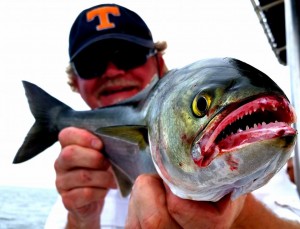 Just as predicted, we’re right in the middle of the best summer for light tackle fishing in recent memory. Right now we have thirty-inch-plus stripers in shallow water above the bridge, and hoards of marauding bluefish down south. Here’s what it looks like:
Just as predicted, we’re right in the middle of the best summer for light tackle fishing in recent memory. Right now we have thirty-inch-plus stripers in shallow water above the bridge, and hoards of marauding bluefish down south. Here’s what it looks like:
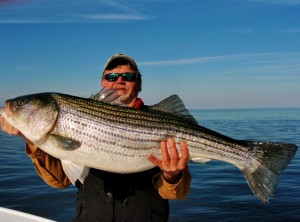 I may have found the best fishing spot in the Chesapeake Bay. I discovered it completely by accident a few years ago. I was zig-zagging across some ledges in the Mid-Bay when I saw something on my fish finder that looked like a miniature underwater forest. My first thought was that I was seeing small tree trunks or the remains of fence posts coming up from the bottom. Then I thought maybe I was seeing a shipwreck, but the more I explored the area, the more it became apparent that my sonar was pinging over more natural structure. I was seeing the sonar returns of oysters, and lots of them.
I may have found the best fishing spot in the Chesapeake Bay. I discovered it completely by accident a few years ago. I was zig-zagging across some ledges in the Mid-Bay when I saw something on my fish finder that looked like a miniature underwater forest. My first thought was that I was seeing small tree trunks or the remains of fence posts coming up from the bottom. Then I thought maybe I was seeing a shipwreck, but the more I explored the area, the more it became apparent that my sonar was pinging over more natural structure. I was seeing the sonar returns of oysters, and lots of them.
When oysters are left to grow, they form highly complex and irregular reefs. This is a result of the natural reproduction process by which larvae is set onto existing shells. These new shells clump together with older ones, and grow upward toward the surface. When the reefs go unharvested, they grow into mounds or plumes. When they’re left alone for a long time, the mounds can reach the surface of the water and be visible at low tides. In regions where oysters are plentiful, they call these mounds “oyster rocks.” That’s a term you don’t hear too much in Maryland because there aren’t any oyster rocks left. Read More!
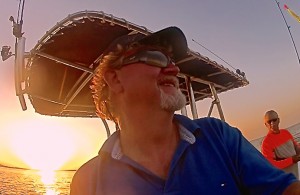 I recently realized that I was missing a lot of what goes on around me when I’m fishing in the Chesapeake Bay due to weakened eyesight. Up to now, I’ve been purchasing drug-store reading glasses that I’d carry around in my tackle bag and drag out whenever I needed to tie on a lure. That worked fine until I started missing little details that my fishing partners were picking up on. I’ve always prided myself in being the first one on the boat to pick up working birds on the horizon. After almost a year of listening to others say, “Do you see those birds?,” I decided reading glasses aren’t enough, and it’s time to make the change to prescription glasses. Since I wear sunglasses most of the time when I’m fishing, I moved on to prescription sunglasses as well.
I recently realized that I was missing a lot of what goes on around me when I’m fishing in the Chesapeake Bay due to weakened eyesight. Up to now, I’ve been purchasing drug-store reading glasses that I’d carry around in my tackle bag and drag out whenever I needed to tie on a lure. That worked fine until I started missing little details that my fishing partners were picking up on. I’ve always prided myself in being the first one on the boat to pick up working birds on the horizon. After almost a year of listening to others say, “Do you see those birds?,” I decided reading glasses aren’t enough, and it’s time to make the change to prescription glasses. Since I wear sunglasses most of the time when I’m fishing, I moved on to prescription sunglasses as well.
 It turns out there’s a lot more to know about sunglasses than I thought. I went for many years using the cheapest sunglasses I could find. I’m paying for that mistake now with diminished vision and hypersensitivity to light. It all comes down to ultraviolet (UV) rays. Inexpensive, off-the-rack sunglasses provide very little or no UV protection. They darken your vision, but they don’t block the damaging rays. The darkening causes your iris to open wider than usual and allow more light, and therefore more UV rays, to injure your eyes. You don’t notice it so much when you’re young, but as you get older, it becomes a lot more obvious.
It turns out there’s a lot more to know about sunglasses than I thought. I went for many years using the cheapest sunglasses I could find. I’m paying for that mistake now with diminished vision and hypersensitivity to light. It all comes down to ultraviolet (UV) rays. Inexpensive, off-the-rack sunglasses provide very little or no UV protection. They darken your vision, but they don’t block the damaging rays. The darkening causes your iris to open wider than usual and allow more light, and therefore more UV rays, to injure your eyes. You don’t notice it so much when you’re young, but as you get older, it becomes a lot more obvious.
My search for the right sunglasses started with some background research about polarization. I learned that light waves normally enter our eyes from all directions. When light is reflected from a surface – like water – the waves orient themselves along a single, horizontal axis. When the waves line up, it’s called polarization and results in very bright concentrations of light. It’s not only harmful to the eye, but it can make it difficult to see clearly.
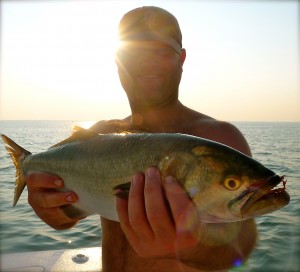 Not long ago we took breaking bluefish and rockfish for granted in the Chesapeake Bay. Unfortunately, times have changed. Since there are a lot fewer fish now, we have to look a lot harder and longer for summer breakers. Granted, it’s easier on some days than it is on others. In my book, Chesapeake Light Tackle, An Introduction to Light Tackle Fishing on the Chesapeake Bay, I dedicate several pages to methods for locating breaking fish. The best strategy for finding blitzing fish under working birds is to head straight for the closest oyster bar. In my reports, I often mention that I find fish over live, hard bottoms. By that, I mean places where there are active shellfish populations.
Not long ago we took breaking bluefish and rockfish for granted in the Chesapeake Bay. Unfortunately, times have changed. Since there are a lot fewer fish now, we have to look a lot harder and longer for summer breakers. Granted, it’s easier on some days than it is on others. In my book, Chesapeake Light Tackle, An Introduction to Light Tackle Fishing on the Chesapeake Bay, I dedicate several pages to methods for locating breaking fish. The best strategy for finding blitzing fish under working birds is to head straight for the closest oyster bar. In my reports, I often mention that I find fish over live, hard bottoms. By that, I mean places where there are active shellfish populations.
I typically plan all my fishing trips so that I keep my boat over as many oyster bars as possible. That includes when I’m just running from one place to another. For fish to feed on the surface in the Chesapeake Bay they need three primary ingredients. In the book, I abbreviate the formula like this: C + B/HB = BF. That’s current plus bait over hard bottoms equals breaking fish. Read More!
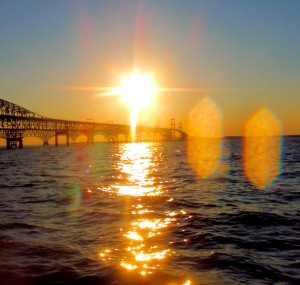 We interrupt this hurricane blog to bring you a fishing report. Yes, this IS a website dedicated to light tackle fishing, and on most Sunday evenings, that’s what I do. I spent most of the day singing the lumberjack song with chainsaw in hand, cutting up the trees and limbs that fell in our yard. After seeing all the trees down around Kent Island today, I’m surprised that we didn’t have more damage than we did. We are also fortunate that the only complete tree that was uprooted in our yard fell harmlessly instead of taking out our picket fence or part of the church next door. We worked on the house and yard most of the afternoon, finishing about 5:00 PM. That left just enough time to go fishing.
We interrupt this hurricane blog to bring you a fishing report. Yes, this IS a website dedicated to light tackle fishing, and on most Sunday evenings, that’s what I do. I spent most of the day singing the lumberjack song with chainsaw in hand, cutting up the trees and limbs that fell in our yard. After seeing all the trees down around Kent Island today, I’m surprised that we didn’t have more damage than we did. We are also fortunate that the only complete tree that was uprooted in our yard fell harmlessly instead of taking out our picket fence or part of the church next door. We worked on the house and yard most of the afternoon, finishing about 5:00 PM. That left just enough time to go fishing.
I launched Thunder Road at Matapeake and ran north to the Bay Bridge. Winds were about 12 knots out of the west when I started, but came down to near zero as the evening wore on. The water was stained, but not as much as I expected. Water temperature and air temperature were exactly the same at 76 degrees. That’s significant because the water has been well into the 80s. It means there was a lot of top-to-bottom mixing due to the storm. I did expect the fish to be freaked out and hunkered down, and they were. I gave the Bay Bridge a good shot, but only caught one little rockfish. I thought the fish might be deep, so I started my fishing trip looking for more of a winter pattern. I marked a few fish deep, but I couldn’t get them to bite. I moved to the shallow pilings and there wasn’t anything going on there either. Read More!
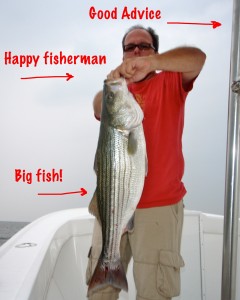 No man, after catching a big fish, goes home through an alley. – Ancient Chinese Proverb
No man, after catching a big fish, goes home through an alley. – Ancient Chinese Proverb
Maybe you’ve heard someone recite another old saying about “the three stages of a fisherman’s life.” It goes something like this: The first stage is when the angler’s main objective is to catch as many fish as possible, the second stage is when the angler only searches for the larger fish, and the third and final stage is when size doesn’t matter and the capture is unimportant, but satisfaction comes from the way the angler tricks the fish. I usually nod my head in agreement when I hear that, but c’mon now, I don’t know one single fisherman who, when given a choice, doesn’t cast toward the biggest fish in the pond. We can wax poetic about the joys of baptizing ourselves in the boundless beauty of nature, and we can sing the praises of that peaceful solitude we find out on the open water, but screw it – the bottom line is, no matter how we are fishing, we want to catch a whopper! In this third and final segment of the Gimme a Breaker series, we’re looking at ways to get the lunkers out of surface blitzing Chesapeake rockfish. Read More!


